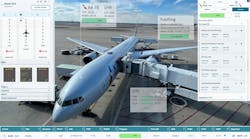In their 2008 book Nudge, economist Richard Thaler and legal scholar Cass Sunstein observe that even though people believe instinct usually leads them to the best decisions, they’re worse at knowing what’s good for them than they realize. Often, they need more help then they think—a subtle hand on their shoulder guiding them this way or that. In other words, a nudge.
There might not be any gathering place in existence where people are more in need of a gentle nudge than an airport. Harried, exhausted travelers must navigate dozens of inconveniences and distractions, from weather delays to backed up security lines to gate changes, often under stress because they have an important work presentation ahead of them, they’re missing their loved ones, or they’re afraid to fly. Although there are certainly thousands of frequent flyers who stream through airports every day, there are also a significant number who are in an unfamiliar place and don’t know the quickest way to the bathroom or where to get the best meals for kids. But regardless of their level of experience, pretty much every traveler needs a little help navigating the trip at some point.
Digital signage already pervades most airports, guiding travelers to their gates, to shops where they can pick up last-minute souvenirs, and places where they can charge their phones. Emerging technologies, however, can make that signage work even harder for you — thereby making life easier both for travelers as well as airport staff.
Signage that predicts what customers need based on a broad characterization of who they are is the next frontier in creating a streamlined airport experience — giving guests a thoughtful nudge in the right direction for them. These days, you can pair digital signage with a business intelligence platform equipped with anonymized mobile device sensors, video sensors, and RFID tracking that allow you to gather data about travelers and instantly convert it into action.
Understanding the options
Mobile sensors can help you understand how people move through the airport: where they spend their time and for how long; where you could benefit from more device charging stations; where you need extra seating; where an extra monitor would prevent people from rushing the gate agent; and so on. Such a feature doesn’t require access to a server because it doesn’t collect any identifying information about the mobile devices — it simply tells you the number of people who came through a space at a certain time and how long they stayed. You can then use a dashboard to look at a heat map, analyzing the collective journeys customers take through the airport.
Next come demographic video sensors, which use facial detection technology to analyze who your customers are in the broadest of strokes. They can’t tell you exactly who a person is; they can identify that a traveler is, for example, a 22- to 27-year-old woman. They can then combine that data with other information, such as the fact that it’s a sunny day and there is a flight delay, and put it all together to trigger content when she approaches digital signage that is most likely to help a passenger like her. In this scenario, that might mean an ad for an airport bar that’s near a large bank of windows, suggesting that she can enjoy a beverage with the sun streaming in while she waits for her plane.
The sensors work like this: A traveler stops in front of a camera that is mounted unobtrusively above. They look at the digital signage in front of them, and the camera captures the geometry of their face — not a photo, but just enough demographic information to flow into an algorithm that will calculate whether that person is male or female, offer a rough estimate of their age range, and note how long they stood in front of the sign. The camera does not capture any personal details — so it does not know precisely who that person is, nor does it collect any data that allows you to follow a specific person’s path throughout the airport. The information is sent to a server on the premises and deleted within 256 milliseconds.
As you gather more data, you’ll start to find interesting patterns and can craft content tailored toward those audiences. You might discover that more women fly on Tuesdays, for example, or that men are more likely to travel together on Thursdays. You can start to understand and predict heavy traffic patterns throughout the airport, pinpoint where certain demographics of people linger, and discover new opportunities to use your space and provide more useful information. Then, you can use the signage to redistribute traffic so people are consistently moving through the airport, while you’re advertising services that apply to them, whether they’re frequent flyers or people who probably need a little extra assistance.
If 40 people are gathering on one side of the gate, signage can help disperse that. Sensors will identify that there’s a crowd and populate content in the signage that suggests they head to an area with more open seating. During inclement weather or when many flights are otherwise delayed, gate agents can quickly become overwhelmed. The platform can integrate flight data with the traveler demographics and then trigger content that updates them on the status, freeing the gate agent from answering dozens of similar questions. From the moment travelers walk into the airport, both inside and outside the gate, you’re creating a much better experience.
The platform also gets smarter and more accurate over time. After delivering content, the platform gathers impressions by aggregating demographic data and time spent engaging with content. For example, an ad for an airline club advertising a $10 discount might be triggered 22 times a day. This can then be cross-referenced from data on the club about the mix of age and gender among the customers who came in, as well as what time they arrived and how long they stayed. You can then inform your digital content strategy using artificial intelligence that gives you precise answers instead of making assumptions. Ultimately, you’ll also be increasing revenue by delivering not just marketing messages to all customers, but exactly the right marketing message for individual customers.
Meeting your goals
If you’re considering such a platform, it’s important to look for a partner who provides wrap-around support not just during the installation but on an ongoing basis through the technology’s useful life. Every installation should start with a site survey to determine where to place sensors and how to angle them so that you’re able to capture the right data for your needs. You’ll also want a partner who’s willing to sit down with you, train you on the dashboard, and help you develop plans to meet your goals.
On that note, you also must always think about what your goal is for that data and how it will inform a long-term strategy to grow your business. As your environment evolves, those goals will likely change, so schedule regular check ins to make sure that the data you’re gathering still moves your business forward — and, if necessary, be ready to adapt. That doesn’t have to be overwhelming, though. Often, airports will start with just one or two goals, and then grow from there as the platform gains traction and they learn how to make it work for them.
The bottom line is that knowledge is power. This technology allows you to gather virtually any data point you want and coordinate it into insights — who is in your environment, where they’re going, and where they’re spending their time — at a customizable, granular level. Once you understand who your audience is, you can do anything. And when the thousands of travelers who stream through your airport every day leave feeling like they had a more streamlined, inviting experience than usual, they’ll feel empowered too. All they need is a little nudge.
Kelly Harlin is Analytics Platform Strategist at NEC Display Solutions of America, Inc., serving as the chief strategist and voice of NEC's Analytics Learning Platform (ALP).



